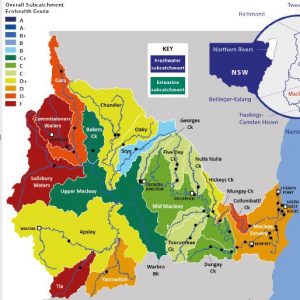What’s Happening to the Macleay River?
 The Macleay ‘EcoHealth’ Project Report was released earlier this year, the Macleay Catchment scored an overall C minus. The project (initiated by the Catchment Management Authority) aimed to provide base-line data to enable Local Councils and State Government agencies to effectively target environmental funding to fix the problems. For the full report click on the link http://www.kempsey.nsw.gov.au/environment/river-management/macleay-ecohealth-project.html
The Macleay ‘EcoHealth’ Project Report was released earlier this year, the Macleay Catchment scored an overall C minus. The project (initiated by the Catchment Management Authority) aimed to provide base-line data to enable Local Councils and State Government agencies to effectively target environmental funding to fix the problems. For the full report click on the link http://www.kempsey.nsw.gov.au/environment/river-management/macleay-ecohealth-project.html
The Macleay catchment is under a number of environmental pressures.
In the upper catchment there are potential and current threats including: Past mining practices that have resulted in heavy metal (arsenic and antimony) contamination; stock grazing and fertiliser runoff from the agricultural sector impact on nitrate levels; there is concern about toxins leaching into the catchment from the Armidale land fill; and logging in the Styx River State Forest and other areas, impacting with sediment runoff.
‘The Gorge country’ then saves the day, re-oxygenating water and diluting Nitrates. But unfortunately, does not filter toxins and heavy metals coming down the river from past mining practices.
In the mid-catchment area, stock having access to the river causes erosion and fertiliser run-off adds to the nitrate levels. Also the impact of gravel extraction on the mobility of arsenic and antimony needs investigation. Dumping of rubbish and poor mine rehabilitation adds pressure, and recently there were reports of dead cattle being dumped in the river.
In the Estuary there are acid sulphate problems, caused by land drainage in low areas of acid sulphate soils. This causes severe degradation of aquatic life and dissolves oyster and other crustacean shells. There are hot spots of arsenic and antimony on the flood plains, deposited in floods.
There is good news…
The current operators at Hillgrove Mine, on the edge of the escarpment, have invested significantly in infrastructure to stabilise mineral waste and to manage water; there is currently an audit of derelict mines on the Macleay and some remediation work is planned; with SOMR’s assistance Southern Cross University are exploring the mobility of heavy metals in a long-term study.
The rehabilitation of the Yarrahapinni Wetlands demonstrates that a resurgence of fish populations and marine diversity is feasible and possible; North Coast Local Land Services’ proposed remediation of the Clybucca Wetlands, a major contributor of acid sulphate and low dissolved oxygen to the Estuary will lead to a significant boost to the fishing, oyster and tourist industries and create a habitat for migrating birds, as well as reduce ‘black water’ entering the restored Yarrahapinni Wetlands.
While there are some improvements, we (SOMR) are still concerned about the contamination sources and would like to know what actions Local and State Government bodies will take to protect and improve the quality of water in our catchment. In particular we are looking to Kempsey Shire Council and Armidale Regional Council and ask them to assert their authority when granting and monitoring DAs with potential impacts on the health of the Macleay River.
And, importantly, we are considering what actions can we, as a community and Save Our Macleay River Inc, take to be part of the solution?
If you want to take part in finding solutions join SOMR http://www.saveourmacleayriver.com/
